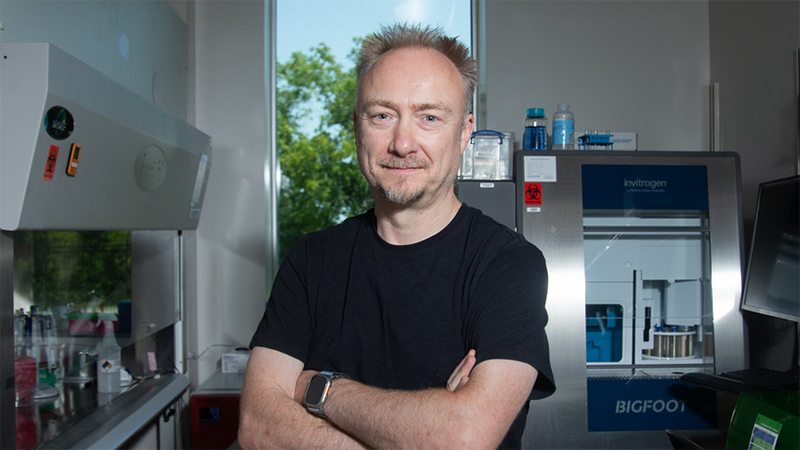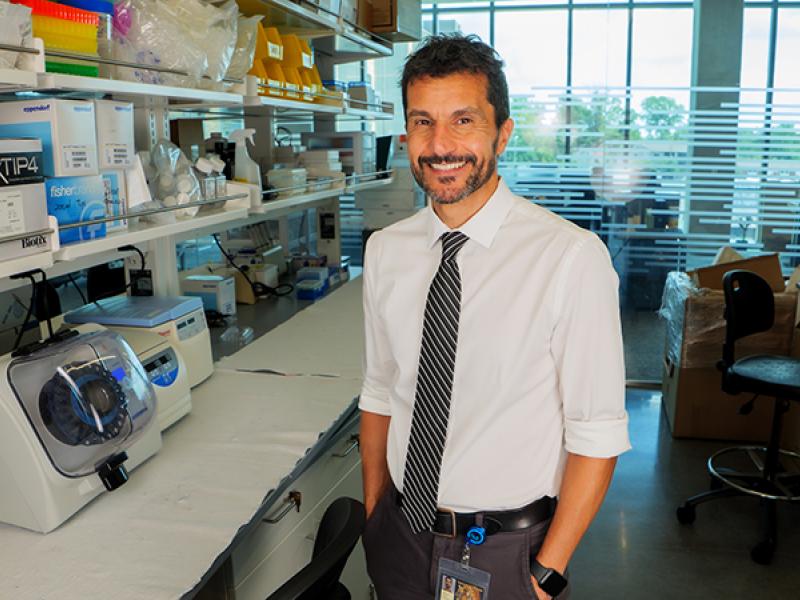
By Sarah Rubinstein | Bond LSC
Growing up in ’70s and ’80s Britain, 10-year-old Anthony Griffiths’ brain had the dangers of rabies seared into it during European vacations. At the time, rabies hadn’t made its way to Britain but was present throughout the continent, and the public service announcement posters were a fearful reminder to remain vigilant. While messages warning against smuggling unquarantined pets into the country scared most children with statements like “rabies means death” and “rabies is a killer,” Griffiths was curious. He went to the library instead, checked out a book — “Rabies: The Facts” and his interest in virology was born.

“I’m the luckiest person in the world, who’s done exactly what I have always, always wanted to do,” he said.
The British native arrived at Mizzou in July to become the newest director of Mizzou’s Laboratory for Infectious Disease Research (LIDR) and a principal investigator at Bond Life Sciences Center.
Griffiths has spent his career researching viruses in high and maximum biocontainment labs, working to understand how they cause disease and how the information he finds can be used to develop vaccines and therapeutics for those viruses.
“Viruses are so simple, they are not even alive, but they are so devastating,” he said. “Understanding how something so simple can have such an impact is fascinating.”
He received his Ph.D. in virology at the University of Cambridge and studied herpes viruses at Harvard Medical School, focusing on the cellular biology of herpes and using antiviral agents to probe how the virus causes disease. Then he began his own infectious disease laboratory at Texas Biomedical Research Institute where his team mostly analyzed viruses at biosafety levels three and four (BSL -3 and BSL-4). Biosafety level four is the highest classification of biological safety for working with the highest risk viruses. In Texas, he looked at a pathogenic zoonotic virus that causes herpes B virus. He also worked on more “famous” viruses like Ebola.
After that, Griffiths was recruited to the National Emerging Infectious Diseases Laboratories at Boston University that had a BSL -4 facility. He worked in Boston through the beginning of the COVID-19 pandemic, where he looked at ways to recycle personal protective equipment used in labs and began looking at passive ways to inactivate the virus on surfaces then tested drugs and vaccines as they started to be developed.
Coming to Mizzou, Griffiths is fascinated with Bond LSC’s ambitious nature that pushes for collaboration with other parts of campus including the School of Medicine and the College of Veterinary Medicine.
“Every university would tell you it values collaboration, but I think Mizzou really strives to have everyone work with each other,” he said.
Griffiths looks forward to the possibility of working with students and hopes being located on the main campus will help facilitate interactions with them. Unlike the work he did in Boston, Griffiths is interested in putting on his biologist hat to investigate animal modeling in his academic lab at Bond LSC where he can recruit students to study the intersections between humans and animals.
While half of his time will be at Bond LSC, directing LIDR also is a substantial undertaking.
LIDR, one of only 13 federally supported Regional Biocontainment Laboratories in the U.S., has research laboratories for studying basic biology of infectious diseases in high biocontainment, such as plague and avian influenza virus. But LIDR also serves as a regional resource of the federal government in the event of infectious disease outbreaks.
As LIDR’s director, Griffiths will focus on outreach to campus and spreading awareness of it as a fundamental resource to the area. He also will represent the lab in national and international conferences. He is most looking forward to bringing in new viruses and techniques to study. As a federal and regional resource, LIDR will study whatever pathogens are most important and relevant for public and animal health to the U.S. at any point in time. Therefore, he and his team will be ready to respond to whatever is needed. He likens this to transitioning a lot of his former work to studying SARS-CoV-2, the virus that causes COVID-19.
From a scientific standpoint, he is most excited to study hantaviruses because he’s never had the chance to study them before, but notes that this could be pushed down on the priority list as new things arise.
“Reacting to what’s happening is part of the job, that’s why you recruit lab members with a variety of expertise,” he said.
Coming onto campus with two big roles, Griffiths wants his future colleagues and students to understand why he chose Mizzou. He believes that the school’s friendly nature, field of opportunities and push for collaboration makes it the ideal place for him.
Article originally published on Decoding Science August 6, 2024





